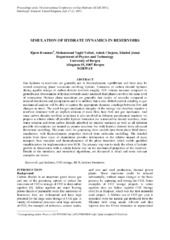Simulation of hydrate dynamics in reservoirs
Chapter, Peer reviewed
Permanent lenke
https://hdl.handle.net/1956/8046Utgivelsesdato
2011Metadata
Vis full innførselSamlinger
Originalversjon
In: Proceedings of the 7th International Conference on Gas Hydrates (ICGH 2011), Edinburgh, Scotland, United Kingdom, July 17-21, 2011Sammendrag
Gas hydrates in reservoirs are generally not in thermodynamic equilibrium and there may be several competing phase transitions involving hydrate. Formation of carbon dioxide hydrates during aquifer storage of carbon dioxide involves roughly 10% volume increase compared to groundwater. Dissociation of hydrate towards under saturated fluid phases involves the same level of contraction. Hydrate phase transitions are generally fast (scales of seconds) compared to mineral dissolution and precipitation and it is unlikely that a time shifted explicit coupling to geo mechanical analysis will be able to capture the appropriate dynamic couplings between flow and changes in stress. The need for geo mechanical integrity of the storage site therefore requires a reservoir simulator with an implicit solution of mass flow, heat flow and geo mechanics. And since carbon dioxide involved in hydrate is also involved in different geochemical reactions we propose a scheme where all possible hydrate formation (on water/carbon dioxide interface, from water solution and from carbon dioxide adsorbed on mineral surfaces) as well as all different possible dissociations are treated as pseudo reactions but with kinetics derived from advanced theoretical modelling. The main tools for generating these models have been phase field theory simulations, with thermodynamic properties derived from molecular modelling. The detailed results from these types of simulations provides information on the relative impact of mass transport, heat transport and thermodynamics of the phase transition which enable qualified simplifications for implementation into RCB. The primary step was to study the effect of hydrate growth or dissociation with a certain kinetic rate on the mechanical properties of the reservoir. Details of the simulator, and numerical algorithms, are discussed in detail and some relevant examples are shown.
